
Yoga is one of the most popular exercise styles in the world. Its beauty lies in its is its adaptability – there are so many styles and disciplines that you’re certain to find one that works for you and your body. A recent study showed that the ancient tradition of practising a yoga flow can actually boost mood and act as an antidepressant. At the most basic level, it’s also a great way to strengthen muscles and keep joints mobile and flexible, especially as you age.
Whether you’re a dedicated yogi capable of flowing seamlessly from downward dog into crow pose, or you’re far more comfortable lying on your back in corpse pose, the only thing you really need for your practice is a decent yoga mat. There are far fewer bells and whistles in yoga than in other sports and disciplines, but a good mat is essential.
However, there are thousands of options to choose from, and you’d be surprised at how many things can go wrong with a yoga mat. Some mats have corners that roll up, or are too slippery for the floor of a hot yoga studio. Some are too thin for your body weight, and some are tricky to carry to class. If you plan to do Pilates on your mat, you might want something spongier; if you’re planning to lift weights and perform dynamic movements, you’ll want something with decent grip.
I tested all the most popular mat styles, from cork iterations to lightweight travel yoga mats, in order to find a clear winner for every category. While I think the Onyx yoga mat is the best option for most people, my years of practice mean I’ve found lots of good options.
How I tested

I tested each mat on three different styles of yoga: vinyasa, hatha, and yin. These mats were tested against flows and poses at home and in studios, and for other exercises that might need a yoga mat, like Pilates or HIIT. When testing, I considered the following features:
- Thickness: The correct thickness varies depending on the practice, but a good yoga mat should offer a little more comfort and support than a flat, bare floor.
- Material: Yoga mats tend to be made from PVC or TPE rubbers and plastics, but some earned bonus points for using sustainable materials like cork or jute.
- Dimensions: Length and width vary from mat to mat, and not everything marketed as a ‘yoga mat’ gives you enough room for your practice. I wanted mats that were wide and long enough for a range of yoga styles.
- Practice: Different practices need different mats. For example, a hot yoga mat needs to absorb sweat, whereas yin yoga practitioners need something thick and supportive.
- Grip: I wanted yoga mats that held their grip on a studio floor, and gave me excellent purchase for different positions.
- Durability: These mats had to stand up to repeated use.
- Travel straps: Yoga mats can be surprisingly unwieldy, so I looked out for mats that come with travel straps.
Why you can trust IndyBest reviews
Emilie Lavinia is The Independent’s fitness and wellbeing editor. She’s been practising yoga since the age of 11 and has tried every yoga style and discipline there is, so she knows what makes a quality mat and a poor imitation. She’s also consulted with hundreds of yoga teachers, studios, mat and accessory designers and yoga experts and academics over the years to broaden her knowledge of the practice.
The best yoga mats for 2025 are:
- Best overall – Onyx yoga mat: £69.99, onyx-fitness.com
- Best budget yoga mat – Myprotein yoga mat: £22.99, Myprotein.com
- Best cork yoga mat – Corkspace pro cork yoga mat: £79, Corkspace.co.uk
- Best luxury yoga mat – Lululemon the mat 5mm: £88, Lululemon.co.uk
- Best training mat – Adidas training mat: £33.99, Decathlon.co.uk
- Best travel yoga mat – La Pochette whenever wherever yoga mat: £60, Lapochette.co
Onyx yoga mat
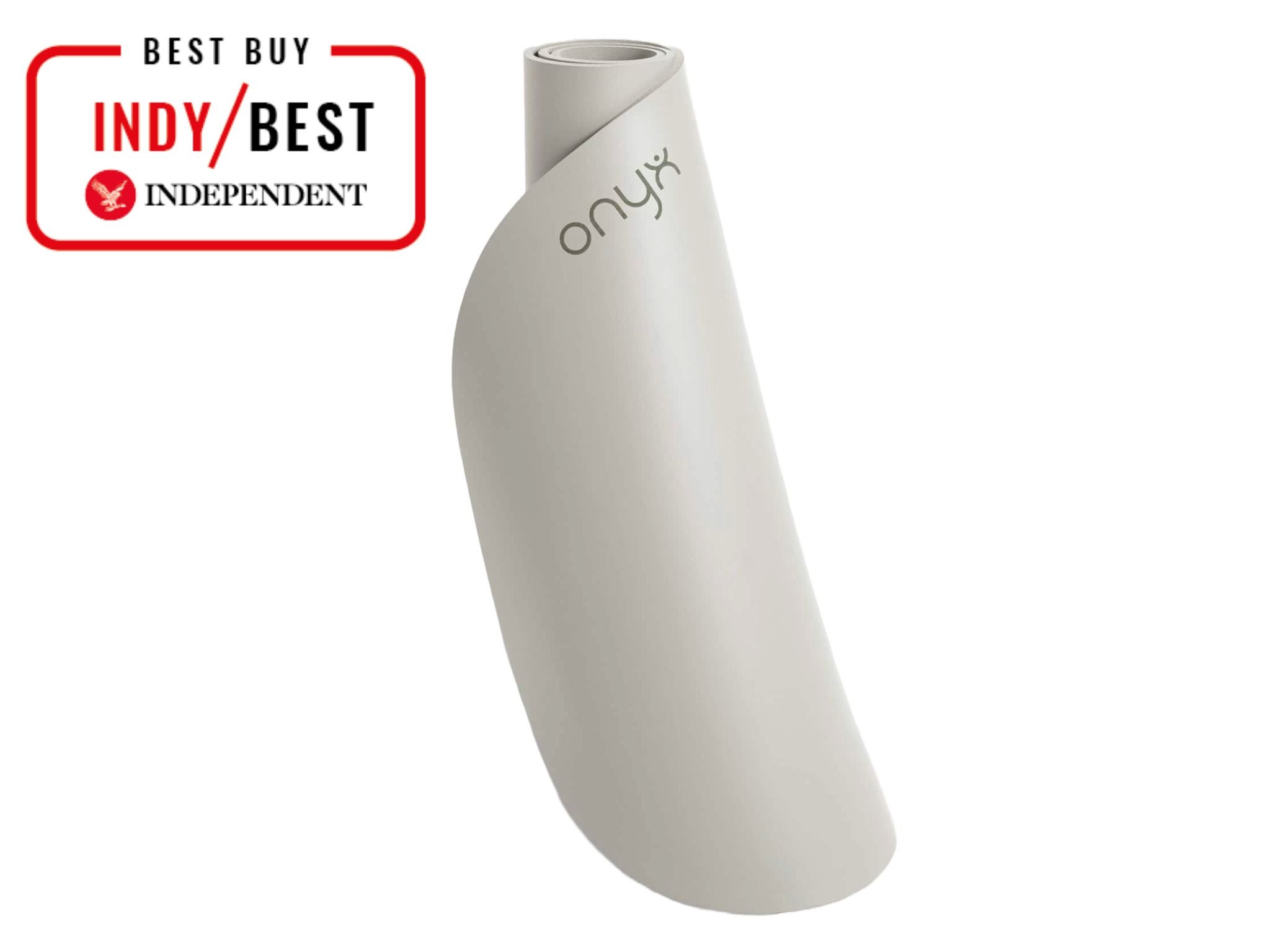
Best: Yoga mat overall
Material: Polyurethane, natural rubber
Size: 180cm x 66cm
Thickness: 5mm
Portable: No
Why we love it
- Extra grippy
- Cool design
- Comes in two thicknesses
Take note
- Heavy to carry
Onyx has created a yoga mat that not only looks great, but it’s incredibly effective. Ultra grippy with a smooth, rubber-like antimicrobial coating and a natural rubber bottom, your hands and feet won’t be going anywhere on this mat.
At 5mm, it’s around medium thickness with a little bounce to it, which is ideal for more seasoned yogis. However, if you suffer from sore joints or struggle with using your mat on a hard surface, you might want to upgrade to the 8mm version (£89.99, Onyx-fitness.com), which offers more cushioning.
.png)
The mat also comes with a velcro strap to help keep it rolled up and in shape when you store it. However, the mat is a little heavy to carry once rolled, so unless you’re feeling strong and invest in a decent carry strap, this one is probably best suited to at-home sessions.
The curved edges look cool and considered and are a nice design touch, along with the textured logo at one side and the range of muted colours to choose from. Of all the mats I’ve tried, this was my favourite.
Buy now £69.99, Onyx
Myprotein yoga mat
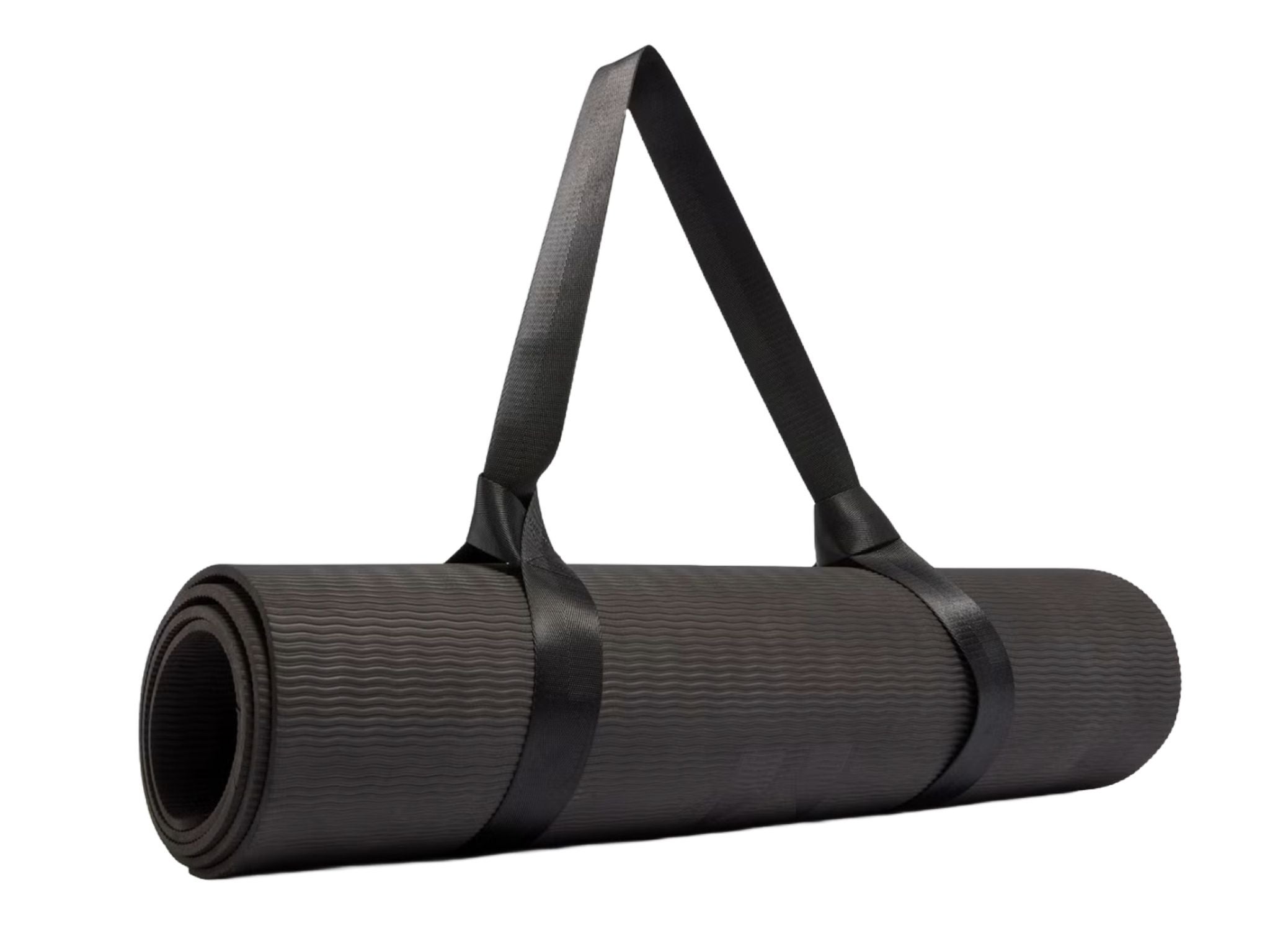
Best: Budget yoga mat
Material: High-density foam
Size: 183 x 61cm
Thickness: 6mm
Portable: Yes, comes with a strap
Why we love it
- Affordable
- Very lightweight
- Textured on both sides
At 6mm thick, the Myprotein yoga mat offers nice density and bounce for an affordable price. It’s ideal if you’re looking for your first yoga mat and you aren’t quite sure what you need.
Made from high-density foam with a wave-pattern texture to ensure ample grip, this plain black mat is a great essential.
It’s also very lightweight, so it’s easy to transport to your classes or take with you when you travel. There’s also a little blank name space for you to label the mat, which should stop you from getting it mixed up with anyone else’s in class or at the airport, which is a nice touch.
Buy now £22.99, Myprotein
Dare 2 B fitness yoga mat
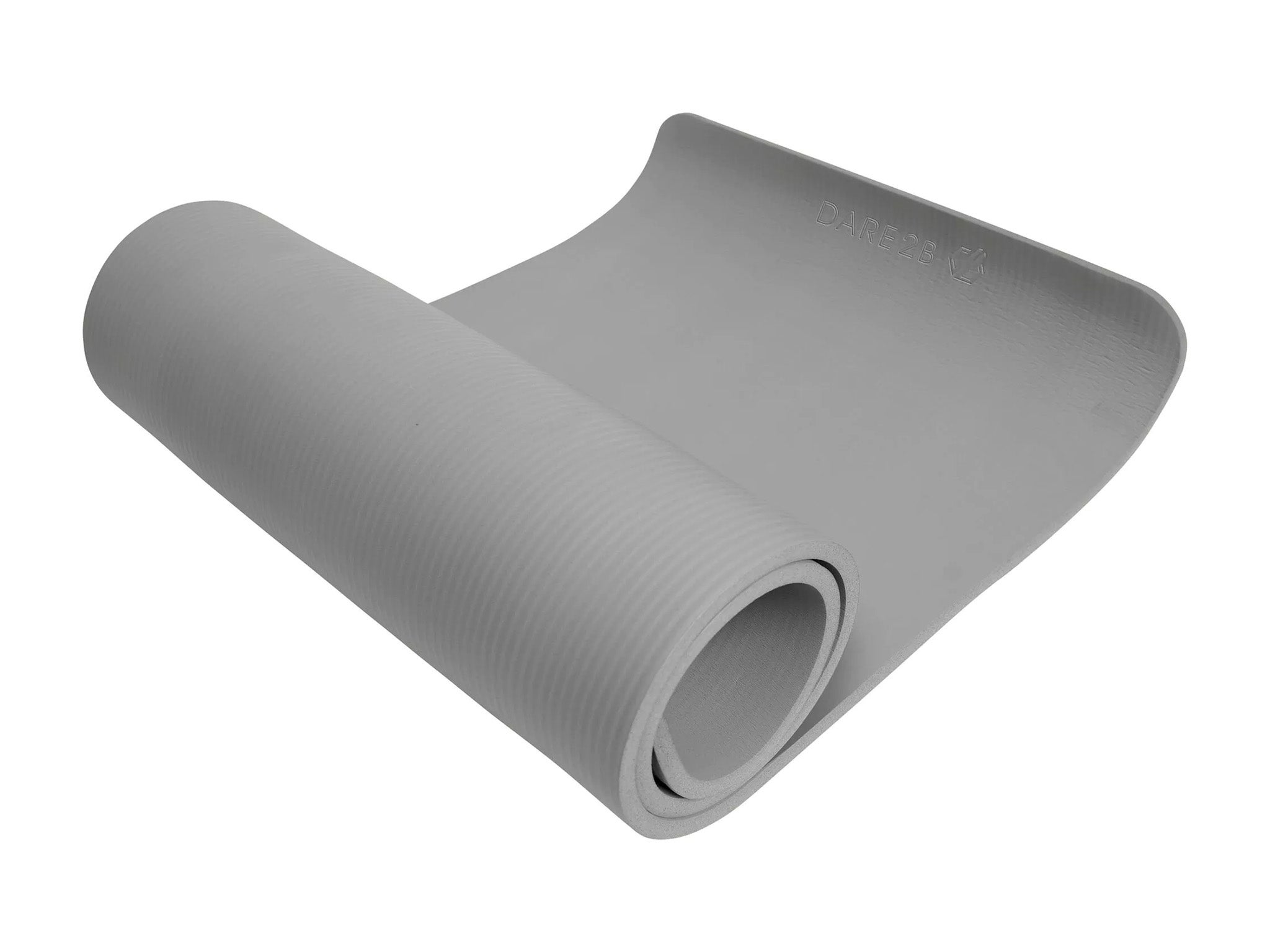
Best: Lightweight yoga mat
Material: Polyvinyl chloride
Size: 183cm x 63cm
Thickness: 4mm
Portable: Yes, it’s lightweight, just add a strap (not included)
Why we love it
- Very light
- Soft and cushion-like
Take note
- Doesn’t come with a strap
- Can become slippy
Incredibly lightweight, this yoga mat is great for those wanting an option that’s easy to cart around. It’s also incredibly soft, showing an imprint of any hand or foot placed onto it – it really does absorb any shock, making it great for those with sore joints.
Made from polyvinyl chloride with a smooth surface, it can get rather slippery after an especially sweaty session, so be sure to have a towel to hand.
For all its great travel credentials, on the website, it looks like this yoga mat comes with a strap, which it doesn’t, so be sure to buy one if you do wish to travel with it.
However, because it’s so lightweight, it rolls up a little at the edges with no extra weight to hold it down. However, this cloud-like quality does make it great for travelling and taking with you to your classes.
Buy now £24.00, Dare2b.com
La Pochette whenever wherever yoga mat
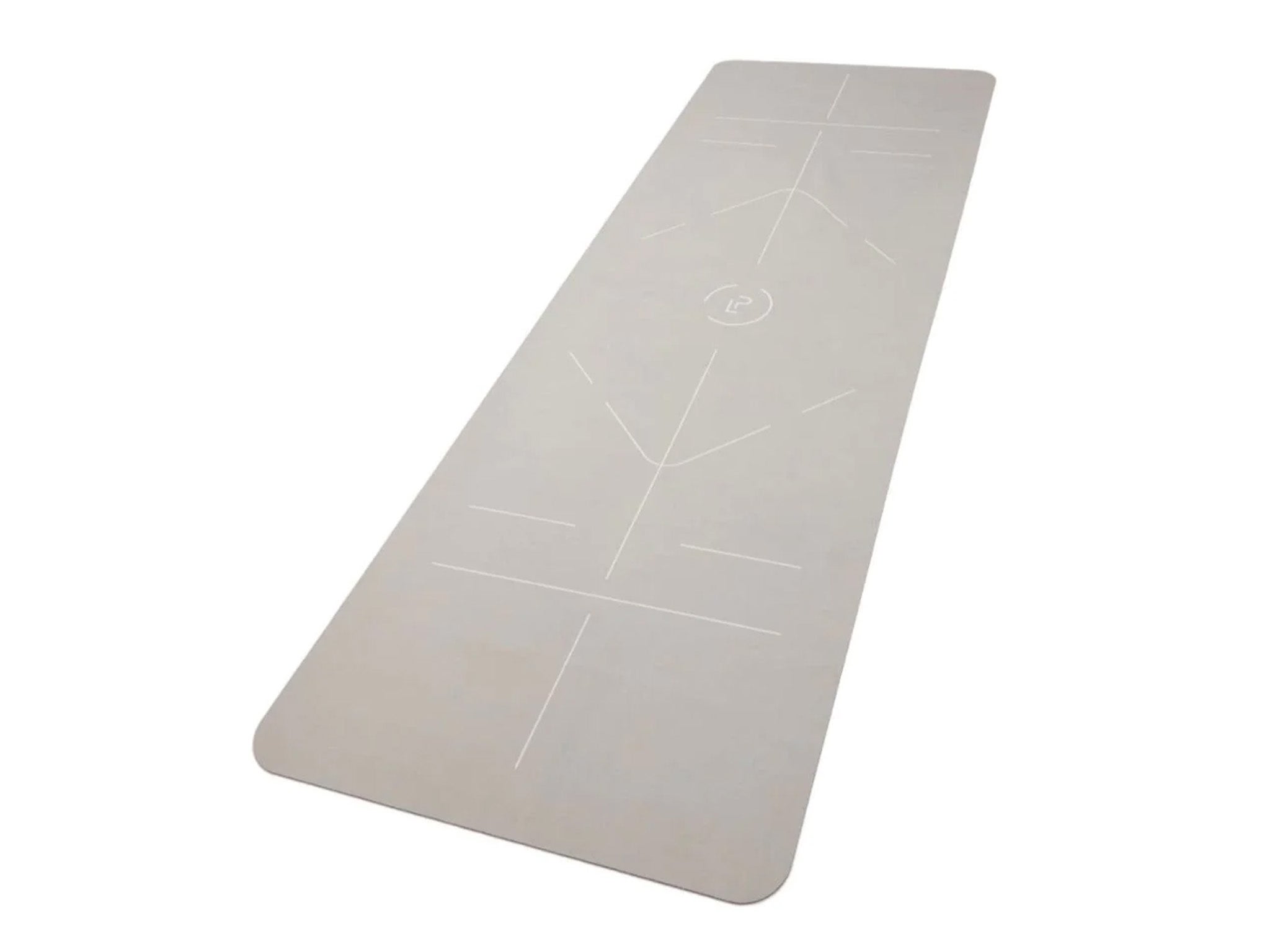
Best: Travel yoga mat
Material: Microfibre and rubber
Size: 183cm x 61cm
Thickness: 1.5mm
Portable: Yes
Why we love it
- Helpful markers for position
- Silky suede texture
Take note
- Very thin
The name of this yoga mat gives the game away – it’s the perfect one to pick if you’re always out and about with your practice. At just 1.5mm thick, the super soft suede-feel mat can fold flat into any gym bag, or roll into an incredibly lightweight and thin tube.
The microfibre suede is an interesting departure from the rubber and PVC mats you might be used to but it feels lovely and soft under the hands and feet. However, at just 1.mm in thickness, it doesn’t offer the most protection for those with sore joints, knees or elbows, so be sure to stay away if this is you.
.png)
I think this is a game-changer for outdoor exercise, and you can even pop it in the washing machine at 30C.
The mat also comes with carefully-placed markings that help you to place your hands and feet, keeping your form in check – especially useful if you’re not practising in your usual environment.
Buy now £60.00, Lapochette.co
Corkspace pro cork yoga mat
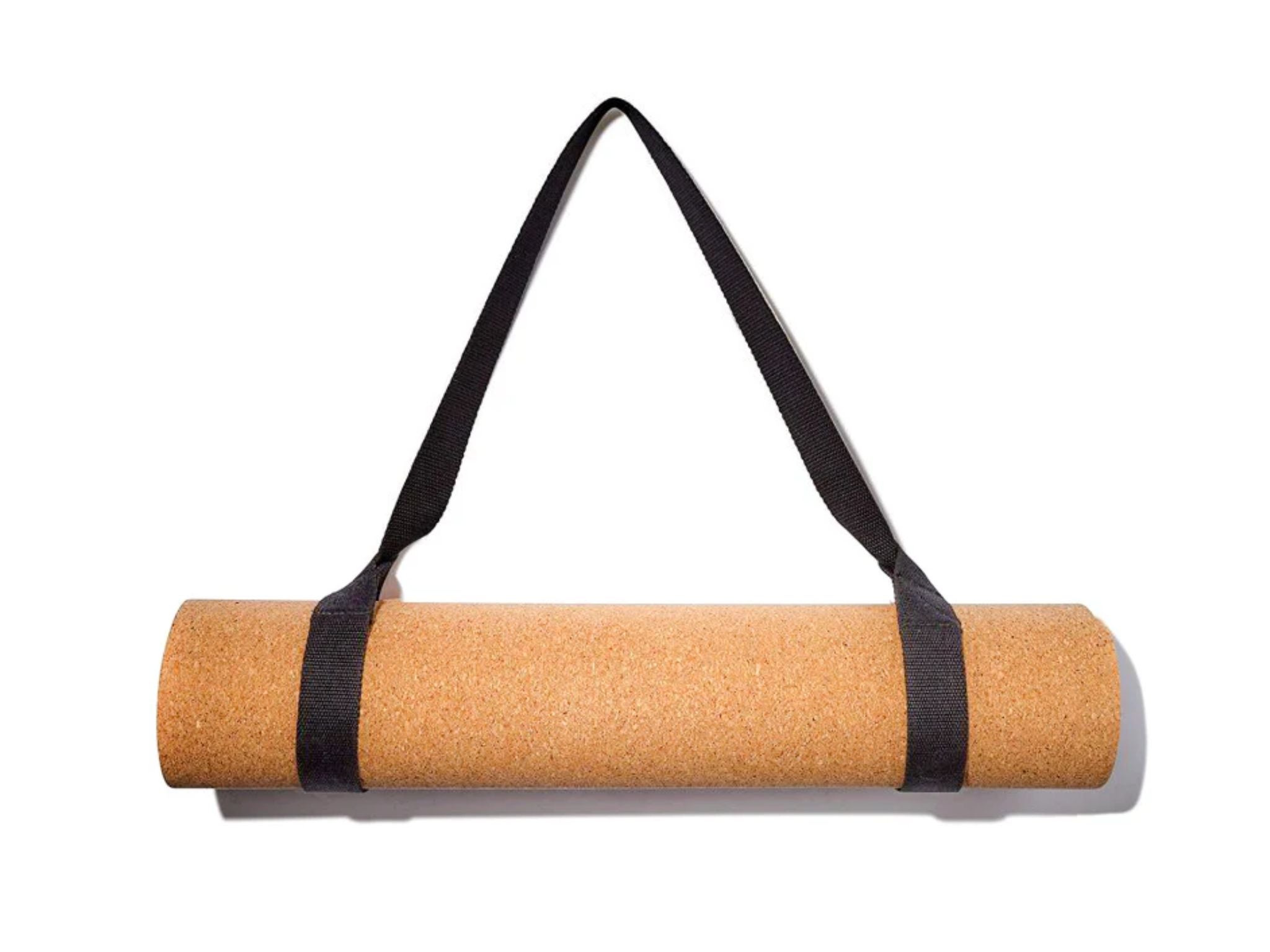
Best: Cork yoga mat
Material: Cork and natural rubber
Size: 183cm x 61cm
Size: 4.5mm
Portable: Yes, comes with travel strap
Why we love it
- Great grip
- Natural antimicrobial properties
- Comes with a travel strap
The Corkspace yoga mat continues to impress me. While it is on the pricier side, I promise you won’t be disappointed.
Made from natural rubber and soft cork, it protects your body from the ground, whether you’re crouching in crow or attempting an inversion. Cork has natural antimicrobial properties and helps to wick away moisture, so it is a brilliant material for a yoga mat, especially if you prefer to opt for something less plasticky.
I found that this mat has the best grip out of any yoga mat I’ve tried, and there are no annoying bumps, thanks to the heaviness of the material.
So, whether you’re diligent about doing your daily downward dog or are new to pilates or yoga, this piece of kit will be a great aid. The brand also stocks small accessories, such as a cork massage ball (£12, Corkspace.co.uk), to add an extra dimension to your practice, too.
Buy now £79.00, Corkspace.co.uk
Fabletics essential yoga mat

Best: Yoga mat for different styles
Material: PVC
Size: 183cm x 68.5cm
Thickness: 6mm
Portable: Yes (if you buy a strap)
Why we love it
- Good grip
- Stays flush with the floor
Take note
- Doesn’t come with a strap
A lightweight mat with a textured, almost sticky grip, the essential mat from Fabletics is a great all-rounder for different types of yoga. Both sides feature a cross-hatch textured pattern to give your fingertips plenty to hold on to, and this also keeps it in place on the floor.
.png)
The mat is a thin to medium thickness but surprisingly weighty, so there are no rolling corners and it’s easy to fold or roll and store. This is helpful as it doesn’t come with a storage strap or carry strap, so if you’re planning to take this mat out of the house, you’ll have to purchase a travel strap separately.
There’s also a discount for Fabletics members, which can make this mat much more affordable – it’s £25.60 for members. But at its non-member price, it’s a great all-rounder for at-home sessions.
Buy now £64.00, Fabletics
Adidas training mat
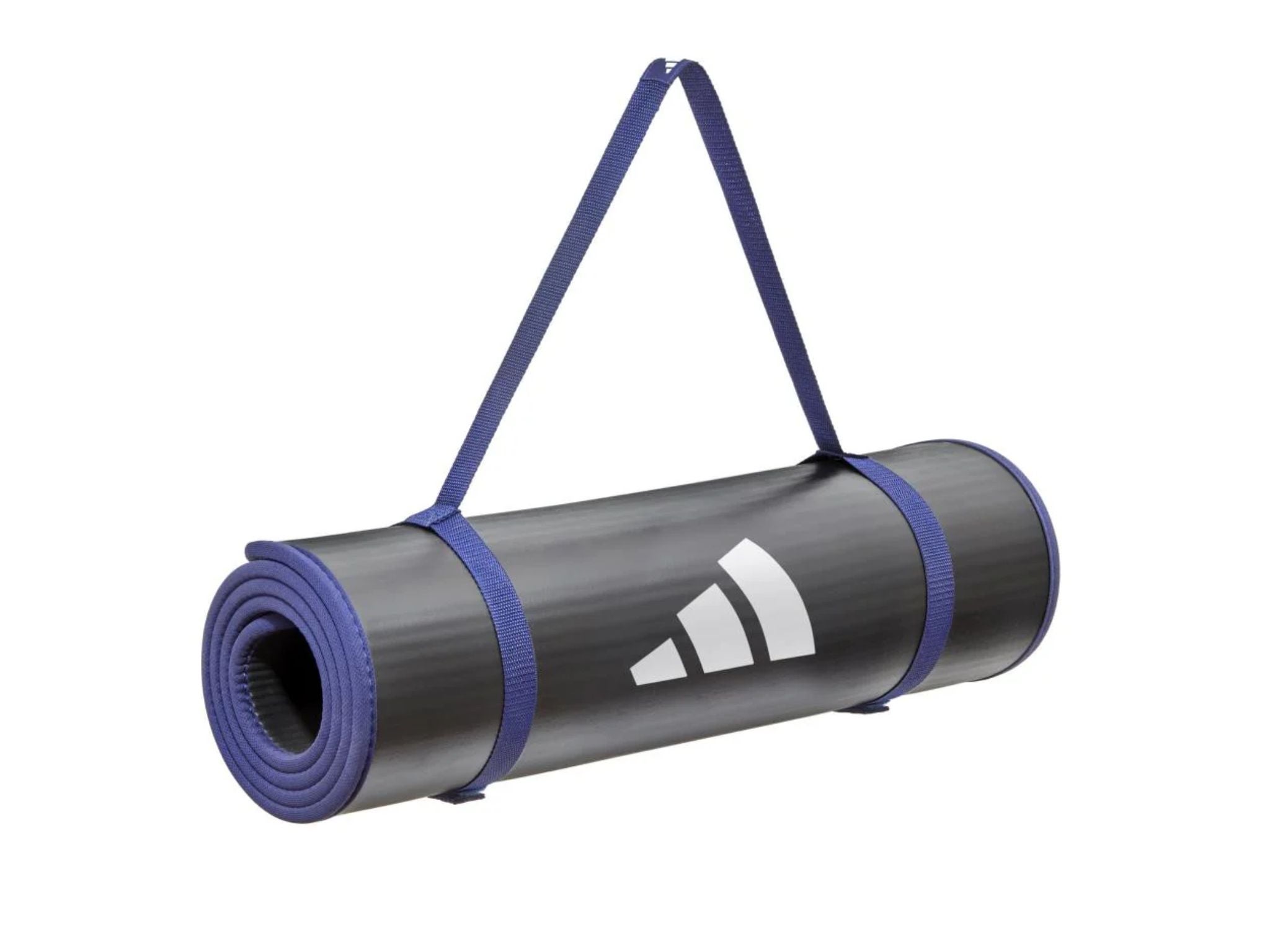
Best: For exercise
Material: NBR (nitrile butadiene rubber) material
Size: 183cm x 61cm
Thickness: 10mm
Portable: Yes
Why we love it
- Plenty of cushioning for exercises like burpees
- Comfortable for lying poses on hard floors
- Comes with a travel strap
Take note
- Thick material doesn’t give good ground feel
- Mat stretches slightly in poses like downward dog
This plush mat falls more into the exercise mat category, but can be used for yoga too. It’s twice as thick as your average yoga mat, with 10mm of NBR rubber providing plenty of cushioning. As a result, I found it was incredibly comfortable for lying poses, whether I used it indoors, outside or on an unforgiving stone floor. The added thickness also felt fantastic for HIIT workout mainstays like burpees and lunges, providing a soft landing when we were required to hit the deck.
However, this mat’s biggest strength (the ample cushioning) is also its most significant shortcoming. The 10mm mat doesn’t offer great ground feel for grippy poses where you’re placing your weight through your hands, such as downward-facing dog and crow. If your hands are pushing forward while in a downward-facing dog pose, the mat can also stretch slightly, reducing stability.
For these reasons, I would recommend it for people who want an exercise mat they can also use for occasional stretching or Pilates and yoga. It could also make a good fit for those who prefer less active practices such as yoga nidra, or want to protect sore joints from hard floors.
Buy now £33.99, Decathlon.co.uk
Fiit training mat
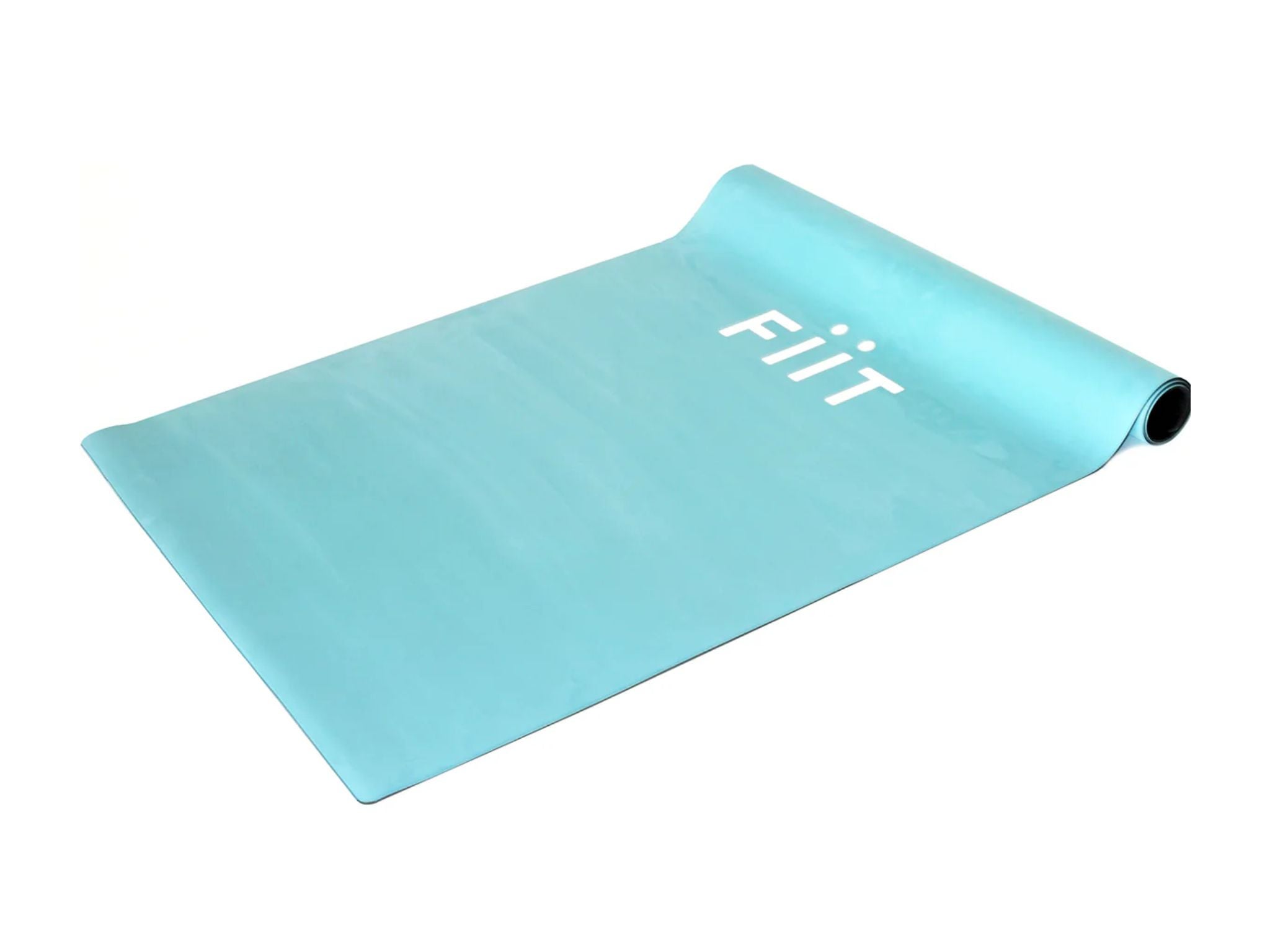
Best: Large yoga mat
Material: Recycled rubber
Size: 180cm x 90cm
Thickness: 5mm
Portable: No
Why we love it
- Large surface area
- Durable
- Made from recycled rubber
Take note
- Hard to travel with due to its size
- Not the grippiest
The average yoga mat is about 60cm wide. This Fiit mat boasts another 30cm beyond this, giving you more space for stretching and complex flows.
I loved the larger surface area for all forms of exercise – I never needed to rearrange my body during a yoga class to stay on the mat, or worry about missing the mat with our hands when dropping into the press-up position during a class.
The recycled rubber underside of the mat was brilliantly sticky, not budging on any surface, even slippery laminate floors. the suede-like top layer is incredibly durable, surviving a multitude of indoor and outdoor classes (and the claws and teeth of my overexcited dog) with little more than a few scuffs to show for it.
The mat didn’t offer as much grip as others on this list, and its larger size means it’s tricky to roll up and take with you on the go. But if you’re after a larger, robust mat, this is a great option at a fairly affordable price.
Buy now £35.00, Shop.fiit.tv
Bala The play mat
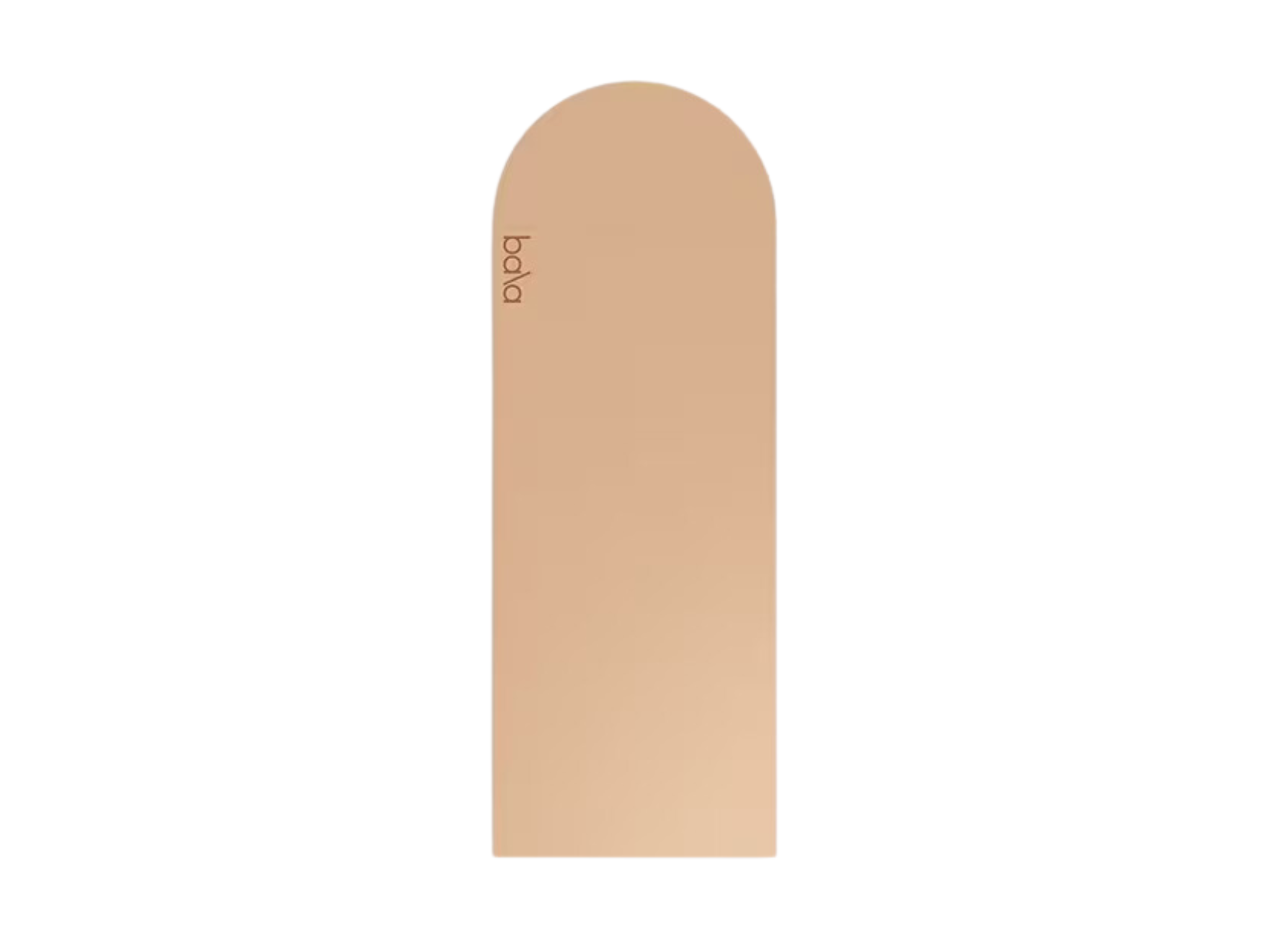
Best: Best yoga mat design
Material: Rubber, polyurethane
Size: 180cm x 67cm
Thickness: 8mm
Portable: No
Why we love it
- Extra thick
- Cool design
- Hardwearing
Take note
- Expensive
Touted by the brand as ‘the world’s most comfortable mat’, the play mat by Bala is 8mm thick to ensure a comfortable practice. While this level of thickness might not suit everyone, it does make a session on a hard floor that much easier.
It was well suited to a range of yoga styles and to Pilates and training with a resistance band. However, the thickness did interfere a little with balance in certain poses.
The design and luxe finish at the edges certainly make up for other shortcomings, as this feels premium. Made from FSC-certified natural rubber and high-grade polyurethane, it’s very grippy and prevents any slipping.
The mat is also pretty hardwearing and easy to clean, so the higher price point will hopefully ensure that you don’t have to replace your mat after a year of use, which can often be the case with cheaper foam-style mats.
Buy now £119.95, Johnlewis.com
Lululemon the mat 5mm
.png)
Best: Luxury yoga mat
Material: Natural rubber, synthetic rubber, polyurethane, polyester, nylon
Size: 66cm x 180cm
Thickness: 5mm
Portable: No
Why we love it
- Cushioned side and grippy side
- Made from quality materials
Not only does this mat look like a 10/10, it feels great and offers decent support. A sustainable natural rubber base offers a little extra cushioning and feels springy under the hands and feet. At 5mm, it’s one of the thicker mats on this list, so it is great for yoga and Pilates moves too.
.png)
It’s reversible with a more cushioned side or a grippier side, which is good for hot yoga and especially sweaty sessions. For those who prefer an all-natural mat, this might not be the one as it contains synthetic materials too. However, the antimicrobial layer helps prevent mould and mildew on the mat, which gives a little peace of mind as this mat is at the pricier end of the spectrum.
The pink and white colourway stands out against a sea of black, and you can also choose from green and blue options. There’s a plain black version too, but I love the colourful iterations for something a little different.
Buy now £88.00, lululemon.co.uk
Complete unity yoga sustainable non-slip jute yoga mat
.png)
Best: Yoga mat for grip
Material: Jute, rubber
Size: 66cm x 180cm
Thickness: 4mm
Portable: No
Why we love it
- Sustainable and eco friendly
- Incredible grip
- Made with natural materials
Take note
- A little heavy
This mat has excellent sustainability credentials, but it’s the grip that’s most impressive. Crafted from a unique blend of jute fabric and tree rubber, this mat offers what Complete Unity calls “complete grip”. Your hands and feet won’t budge, however intense your flow or the heat in the room.
The fabric is a little heavy, and this mat doesn’t come with a strap, so it’s not the easiest to transport, although you can easily fit it in a strap to carry it to and from the studio.
.png)
With 4mm of springy cushioning, it offers plenty of cushioning and spring to protect your joints. It’s also infused with lavender to do away with the rubbery smell that most natural mats give off.
This mat is also free from PU, BPA, TPE, PVC and microfibres, so if you’re living a low-tox lifestyle, it’s better for you and the environment. It’s also vegan and made using a zero-waste process, but it’s luxurious and great quality, proving you really can have it all.
Buy now £66.99, completeunityyoga.com
Your questions on yoga mats answered
Which is the best yoga mat?
Yoga mats come in all shapes and sizes, so be sure to select one that works best for you and your practice. No matter if you’re a beginner or best in class, there are great options to suit you in every style. If you’re keener on a natural material, you can’t go wrong with Corkspace’s cork mat, however, if you’re not as concerned with the coating material, my best in show is the Onyx mat. For a more affordable everyday option, the Myprotein yoga mat won’t steer you wrong.
If you regularly take your practice out and about, the La Pochette whenever wherever yoga mat couldn’t be easier to carry around. And Lululemon’s mat will inject some personality and a little luxury into even the most serene of practices.
Which type of yoga mat should I buy?
Different mat materials have different lifespans and varying levels of grip, explains Cat Meffan, yoga teacher and founder of the Soul Sanctuary. You have various options ranging from natural rubber to rubberlike PVC and plastic coatings. Each offers a different style of grip, and the addition of grooves and textures can make a difference to the efficacy of the material too.
Materials like cork offer natural antimicrobial properties, so they’re great for an option that wicks moisture away and won’t leave you sliding around in a pool of your own sweat. However, they do degrade quicker than something like a PVC mat.
“Some materials, such as cor,k are great, but more so for hot yoga classes, or very dynamic flows when you know you’ll get sweaty. When buying a ‘yoga towel’ or hot yoga mat, be aware that these are often only 1-2mm thick, so you’ll want to have another mat to pad underneath,” says Meffan.
Rubber is another great natural material that offers plenty of grip and natural bounce, especially on a hard floor; however, rubber mats wear down after a while, too. Meffan explains that, “Smooth, recycled rubber mats are amazingly grippy at the start but, on average, they will last for around 300-400 practices. If you’re someone that does yoga everyday, this might feel a little excessive to be buying a new mat each year.”
How thick should a yoga mat be?
“Thickness definitely matters”, says Meffan, “especially if you like extra padding under the knees and spine. But bear in mind that the thicker the mat, the heavier it will be.” While thicker mats are good for using at home, they may be too much for carrying to the gym.”
A yoga or Pilates mat can range from anywhere from 1mm to 12mm in thickness, so consider whether you want something foamy or bouncy, something that absorbs shock and cushions joints, or offers spring and stable underfoot support.
Most standard yoga mats usually measure 3mm thick, while a thick yoga mat starts at approximately 5mm.
Thicker yoga mats are a great option to provide extra support for anyone who suffers from knee pain, sensitive wrists or is looking to practise hatha or restorative yoga.
Why is it important to use a yoga mat?
While you don’t need to use a mat, mats can provide support for your joints, cushion your bones and help you to keep your body aligned within the edges of the mat, which can make your practice easier. “Yoga mats were created to enhance the practice of yoga, and they do a great job of it. If someone had the choice of doing yoga without a mat or not doing yoga at all, I would always urge them to just start,” says Meffen.
“There are many asanas that don’t require a high-grip yoga mat, and let’s not forget that meditation and pranayama are a huge part of yoga, for which we can sit on a cushion or a chair.”
Which type of yoga mat is best for beginners?
Before buying your first yoga mat, there are a few things you need to consider. Firstly, think about what type of floor it will be used on. If the mat doesn’t have enough grip, if you place it on hardwood or tiled floors, it may be difficult to balance in various poses.
Additionally, a non-slip mat will be helpful when working up a sweat or when practising hot yoga in a heated room. If you plan to transport your mat between your home and classes, look for one that’s lightweight and rolls up easily.
How to clean a yoga mat
Depending on how often you practise and the intensity of your sessions, you can usually go a week or so before your mat needs a thorough clean. But, if you tend to sweat a lot or find that your mat retains an odour, it is best to clean it more often.
For a quick spot clean, you can buy ready-made antibacterial sprays that are designed to be used on both sides of the yoga mat, to kill any germs and eliminate odours. Alternatively, you can mix a few drops of mild dishwashing liquid and two cups of warm water into a spray bottle.
It is also important to check your mat’s specific cleaning recommendations. While some can be spot cleaned only, others are hand-washable and some can even be put in the washing machine on a gentle cycle.
Is there a difference between a fitness mat and a yoga mat?
While it is fine to use just one mat for all forms of exercise, there is a difference between fitness and yoga mats. Those designed solely for yoga are often thinner, longer and have more grip, while standard exercise mats can be a bit thicker to offer extra support for higher-impact workouts.
What materials should I look for in an eco-friendly yoga mat?
A lot of yoga mats contain PVC – a plastic known as polyvinyl chloride – which is what gives them a slight chemical smell when rolled out. If you’re looking for a mat that’s kinder to the planet, you can avoid this material. More eco-friendly options include yoga mats made from natural rubber, cork, cotton or jute.
Make your practice even more comfortable with our pick of the best yoga pants and leggings







